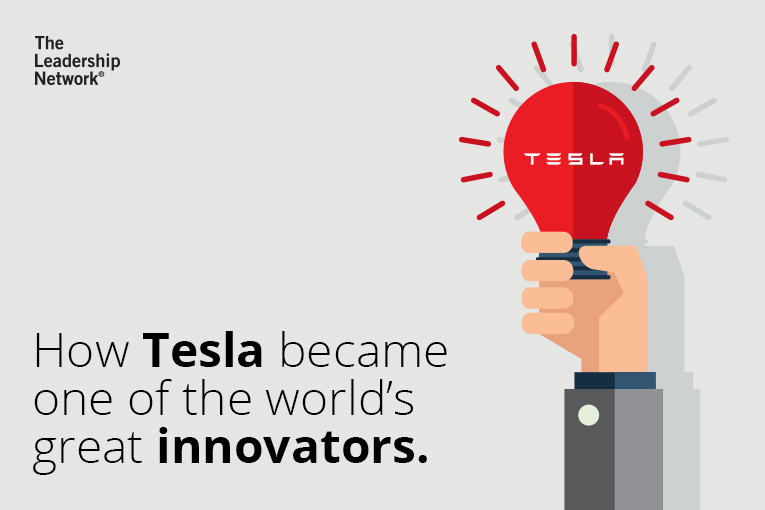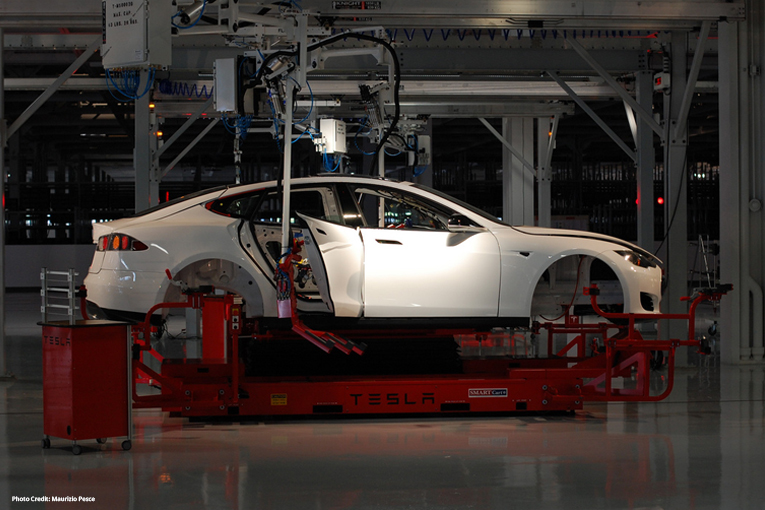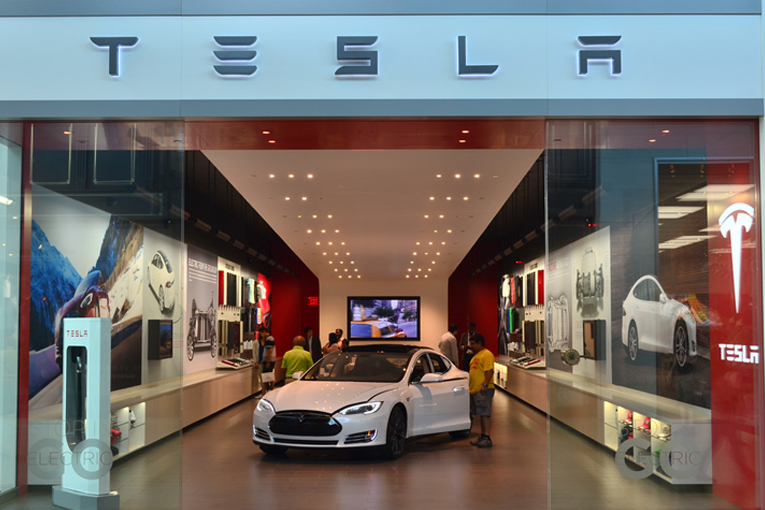
How Tesla became one of the world's greatest innovators.
By Rowan Gibson, published at The Leadership Network reedited by Hugowiz

By Rowan Gibson, published at The Leadership Network reedited by Hugowiz
The Tesla factory in Fremont, California, is a monument to science and progress. Under the roof of this state-of-the-art plant, 160 gleaming silver and red coloured robots, each standing eight-feet high, push the boundaries of technology. In just five days, these mechanical giants and the 3,000 men and women who work alongside them, can fashion a coil of aluminium raw material into a fully functioning Tesla Model S.
Indeed Tesla’s pristine white futuristic facility, which is currently being showcased on YouTube, is quite a sight to behold. I couldn’t fail to be amazed as one metal leviathan stamped a huge laser-cut aluminium panel like a customs official stamping a passport, while another inserted a front seat into a Model S with the manual dexterity of a surgeon.[i] But Fremont, where enormous skylights allow natural sunlight to pour in, is not just a shrine to process efficiency, it is a sanctuary to blue-sky thinking. And at the heart of everything Tesla does is Elon Musk, Tesla Motors’ visionary CEO. For it is the South Africa-born Canadian-American innovator [ii] who is beginning to achieve the unthinkable dream of making sustainable transportation a reality.
In doing so, Musk and Tesla has created a tech-focused super brand that has captured the imagination of the world. Its achievements have not gone unnoticed by global management consultancies too. The Boston Consulting Group, for example, recently ranked Tesla as the world’s third most innovative company.[iii] But what is even more staggering is that BCG only rated Tesla as the 41st most innovative company in 2013. So how has Tesla achieved this magnificent feat and how has it become a world-class innovator?
In this, the first of two blogs, I’ll reveal exactly how Tesla has shattered long-established industry paradigms with its game-changing innovative discoveries. But let me begin by first outlining the 4 Lenses of Innovation – a systematic methodology which I specially developed for enterprises to identify and exploit innovation opportunities wherever they find them. They are as follows:
What if the dominant conventions in your field are outdated, unnecessary or just plain wrong?
Where are the market shifts that will, now and in the future, provide the energy you need to make a major leap forward?
How can you arrange existing skills and assets into new combinations that will create radical new growth opportunities?
What are the unmet needs and customer frustrations that everyone else has overlooked or ignored?

To challenge deeply entrenched beliefs is one of the fundamental drivers of innovation. Galileo, Luther and Columbus have their names etched into the history books for doing exactly that.
In one hundred years’ time, Elon Musk, the man behind Tesla’s meteoric rise, who has arguably forged his career on the principle of Challenging Orthodoxies, might yet join this vaunted pantheon of innovators. Like them, Musk was courageous enough to question what we had all accepted as gospel and it is this contrarian spirit that makes him truly stand out.
He saw a niche in the market for a “technology company making electric cars”[x] and ever since founding Tesla in 2003,[xi] in San Carlos, California he has proved that the dominant conventions dictated by the automotive establishment could be both challenged and successfully overturned.
Musk was brave enough to believe that there was a viable and more sustainable alternative to the traditional petrol-powered vehicle, and he stubbornly refused to listen to the majority of investors and Original Equipment Manufacturers (OEMs) who did not think such a revolution was possible.
Musk is one of the world’s great innovators. And like every successful innovator he is someone who is very good at Harnessing Trends, which is the Second Lens of Innovation. By this, I mean that Musk was one of the first to truly comprehend how emerging developments – in particular the rise of environmental awareness and the falling price of batteries – could fundamentally alter the shifting automotive landscape.
Take the financial crisis that struck the world in 2008, for example. For the majority of the automotive industry it was a dreadful time. In the USA Chrysler and General Motors had to be bailed out by the US government, while the big three’s (Ford, Chrysler and GM) U.S. market share declined from 70 per cent in 1998 to just 53 per cent a decade later.[xii]
However, for Musk the financial downturn represented an opportunity to make his mark. With most of the larger players hamstrung by the financial crisis, innovation investment fell by nearly 30 per cent.
But for Musk, this was the key time to ratchet up Tesla’s innovation spending. And it was the work carried out in the aftermath of the global downturn that provided Tesla with the confidence and impetus to move forward. Indeed if the electric car does ever replace the conventional fuel powered vehicle, then the history books might reveal that this was the critical time when the tech giants stole a march on their automotive rivals.
Perhaps Musk’s greatest skill is not his inventiveness (In addition to Tesla, he co-founded the online payment system, PayPal. He also runs three other tech companies in space transport, energy services and artificial intelligence research [xiv]) but more the fact that he has combined, stretched and leveraged the core competencies and strategic assets of his various companies into one integrated, overarching strategy.
All are inter-linked and share their technology platforms with each other. For example, if you were to closely examine the body and chassis of the Tesla’s Model S, you’d discover that it is mostly manufactured from aluminium. Not only did Tesla realise that aluminium was a fraction of the weight of steel, it was also much stronger. But how did Tesla know this? By cross-fertilising its assets from two different industries, Tesla’s engineers visited Musk’s SpaceX venture and were then able to adapt the aluminium body from its Space X falcon rocket for its cars.[xv]
Musk is also an advocate of prioritising knowledge over experience. He understands the unmet and unarticulated needs of his customers and knows exactly what it will take to delight them, which is the Fourth Lens of Innovation.

It would have been easy for Musk to recruit senior executives from large automakers. But while it might have looked good for Tesla to hire top executives from an established OEM or a Tier-1 giant, Musk knew it would be missing the point. He recognised that in a fast changing world, where conditions are far from certain, it is much more important is to recruit thought-leaders who are capable of solving complex issues through innovative and ground breaking ideas. [xvi]
For example, Tesla is not looking to the automotive heartland of Detroit to recruit the 1,600 employees it needs to cement its position as a market leader in sustainable transportation. Employees from established automotives or Tier-1s need not apply. Instead, Tesla will focus its recruitment efforts on Silicon Valley. But why hire Silicon Valley’s finest, especially when many of them have never even seen an automotive assembly line? [xvii]
No matter. For Musk and his team that is not important. They were quick to realise that the automotive landscape is changing rapidly. The future is increasingly about electric mobility and about software-based vehicles that resemble “iPads on wheels”. It’s about pushing the boundaries of current technologies – i.e battery cell development and the e-Powertrain. And it’s also about pioneering disruptive technologies such as self-driving vehicles.
This requires a level of expertise only found in global technology hubs like Silicon Valley, Bangalore (India) and Zhongguancun in Beijing, China. And it is these bright young computer programmers that Musk has earmarked to be the engineers of tomorrow.
What’s more, he has succeeded in embedding innovation as a deep, enterprise-wide capability inside Tesla. Take Tesla’s bonus and promotion structure, for instance. It is heavily oriented towards ingenuity and inventiveness, whereas at a traditional OEM for instance, bonuses are dependent on how much profit a particular employee generates for the company. But not at Tesla. Instead an engineer is rewarded for doing something that makes the company better or improves a particular product or solves a particular problem for customers.
American inventor, Thomas Edison, famously defined Genius as one percent inspiration and 99 per cent perspiration. Whatever you believe, one thing is certain. Given that invention is now recognised as a key driver of long-term business performance, it is nonsensical for enterprises to believe that innovation somehow happens by chance. It doesn’t. You have work to at it.
Elon Musk knows this better than most. He realised early on that innovation cannot be a comfortable process. Tesla engineers have compared it to “jumping out of an airplane and designing the parachute on the way down.” In a recent biography, for example, Musk recounts how he contracted malaria after holidaying in Brazil and South Africa. What is particularly revealing is that malaria, a life threatening condition which claimed 438,000 [xviii] lives last year, did not seem to concern Musk. Instead, he saw it as a petty annoyance that had robbed him of valuable work time. “That’s my lesson for taking a vacation: vacation will kill you,” he told the biographer.

It’s one thing to generate ground-breaking ideas, and another to put them into practice. But there is one additional variable these days that many innovators fail to take into account. In today’s fast changing economies, markets are moving at breakneck speed and so your innovation offering must do so too.
According to a recent BCG report, 42 per cent of fast innovators are strong innovators.
Tesla, for example, was quick to grasp the importance of speed. Tesla might not be as heavily resourced as some of its OEM counterparts but it manufactures batteries on its US site (Fremont) and because speed to market is vitally important, it prefers to produce the majority of components in its California plant too, rather than rely on the Tier-1 and Tier-2 supply chain.
But the fast-paced ingenuity that Tesla practices is linked directly to the disruptive innovation model that is has adopted. The BCG survey for example also highlights that fast innovators are more disruptive.
The disruptive model that Tesla employs is a result of Musk and his team being bold enough to Challenge Orthodoxies and empathic enough to understand and address the unmet needs of Tesla’s customers.
On the face of it, the paradigm just shouldn’t work. Even Musk himself had his doubts at the beginning. For Tesla’s innovative blueprint does exactly the opposite to traditional financial models. Most retailers for instance pitch their goods at the masses first, and only when they have built up a loyal following do they consider adapting their product for the high-end buyer.
Tesla on the other hand, has deliberately targeted the ultra-premium car consumers from the very beginning, and only when it has made inroads within this luxury car segment will it make a vehicle for the masses.
Tesla hopes to realise this ambition in 2017, when it plans to release its Model 3, which will be sold for USD$35,000 (UK£ 23,000). [xxi]
Lastly, in embodying the 4 Lenses of Innovation, Elon Musk has made invention his USP.
This means that Tesla doesn’t have to play by the same rules as established OEMs. Instead, it can focus all its efforts on reacting to innovative market opportunities such as developing Autopilot, its autonomous car IT system.
As it is not yet turning a profit, it’s not bound by the pressure of having to produce a set number of vehicles each year. Nor is it shackled by the pressure to drive profit. In 2014 for instance Tesla cut its sales forecast by 10% after assembly line automation issues stalled production.[xxii]
This would concern most CEOs, but not Musk. He has seen the bigger picture and understands the unmet needs that everyone else in the automotive space is ignoring.
Tesla’s future is firmly rooted in producing the world’s best car, and installing the correct infrastructure to support this most ambitious of builds.
Over to you, Elon…
You will receive news about new articles, events and workshops about innovation sent by Hugowiz.